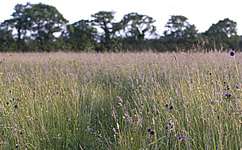Hot days cooled by growth in grasslands

Our changing use of the land may have been taking the edge off hot days, scientists say.
The study, published in Geophysical Research Letters, suggests that the global pattern of replacing trees with grasslands could have been affecting extreme temperatures.
'We find that replacing tree cover with grasslands leads to a weak cooling effect, in the opposite direction of climate change caused by greenhouse gases like carbon dioxide,' says Dr Nikos Christidis from the Met Office, who led the study.
The team used a statistical method to look at historical changes in land use, for the first time examining their effect on the climate in the context of other climate influences.
'Over the last century there have been significant changes in land use,' he explains. 'The main one has been the replacement of trees with grasslands.'
'When you replace trees with grasslands, the surface becomes more reflective.'
'This means that, on hot days, when there is normally lots of sunlight, more heat is reflected back off the surface, leading to a small cooling effect.'
'There are also changes in the energy budget due to alterations in the water cycle, as well as changes in carbon emission or uptake. These are more complicated and can lead to opposite effects in different regions.'
In some parts of the tropics, for example, changes in the water cycle dominate and may make hot days even hotter.
Extreme heat can be a killer. In August 2003, a heat wave that affected large parts of Western Europe led to 2,000 more UK deaths than usual for the time of year.
Christidis warns that any cooling effect created by a growth in grasslands is likely to be far outstripped by warming from greenhouse gases.
'In the 50s and 60s, this was probably taking the edge off extreme hot days but, as time goes by, the effect is being overwhelmed by warming from greenhouse gas emissions,' he says.
Christidis hopes that this work will inspire better representations of the effect of land use change in climate models, ultimately improving predictions of climate change.
More information: Christidis, N. et al. The role of land use change in the recent warming of daily extreme temperatures, Geophysical Research Letters, 2013, DOI: 10.1002/grl.50159
Journal information: Geophysical Research Letters
Provided by PlanetEarth Online
This story is republished courtesy of Planet Earth online, a free, companion website to the award-winning magazine Planet Earth published and funded by the Natural Environment Research Council (NERC).

















